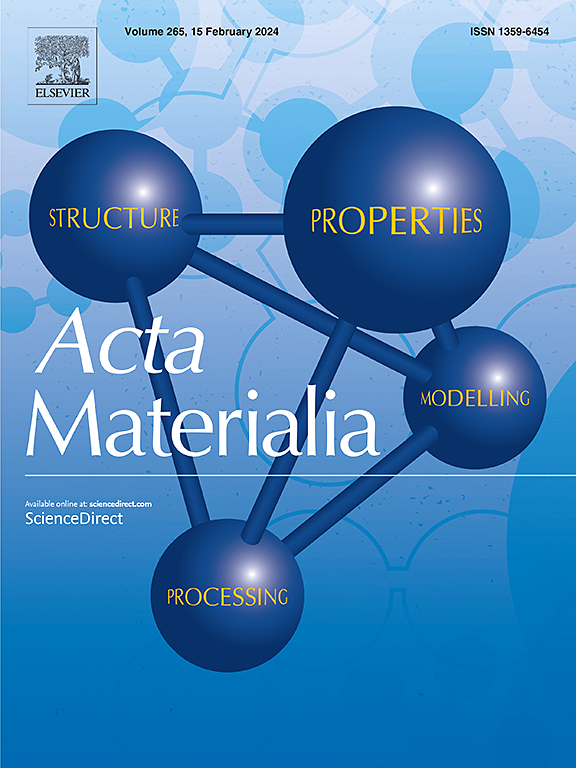石墨烯网络增强和界面取向对镍复合材料力学行为的影响:分子动力学研究
IF 9.3
1区 材料科学
Q1 MATERIALS SCIENCE, MULTIDISCIPLINARY
引用次数: 0
摘要
本研究利用分子动力学模拟研究了石墨烯网络结构和界面取向对石墨烯增强镍(Gr/Ni)复合材料在拉伸和压缩载荷下力学行为的影响。两种石墨烯结构,嵌入在Ni基体中的单片(NiGr[−],0.66 vol%)和十字形网络(NiGr[x], 1.0 vol%),在三个界面方向上进行了评估:Gr/Ni(100), Gr/Ni(110)和Gr/Ni(111)。结果表明,石墨烯增强显著提高了复合材料在所有晶体取向上的强度、刚度和延展性。值得注意的是,Gr/Ni复合材料表现出优异的抗拉强度和杨氏模量,特别是在Gr/Ni(110)和Gr/Ni(111)取向中,以NiGr[x]结构表现出最高的性能。在压缩条件下,复合材料的抗压强度显著提高,其中NiGr[x]结构的抗压强度再次优于其他结构。位错密度分析表明,虽然石墨烯在拉伸下有效地阻碍了位错运动,但在压缩下,由于薄片屈曲和波纹,其影响减小。此外,该研究还强调了Gr/Ni复合材料的显著延展性增强,特别是在Gr/Ni(111)取向中,在失效前,NiGr[x]结构的应变维持在纯Ni的5倍以上。这些发现强调了优化Gr/Ni复合材料在需要卓越机械性能的应用中的潜力,并为先进材料设计提供了有价值的见解。本文章由计算机程序翻译,如有差异,请以英文原文为准。


Effect of graphene network reinforcement and interface orientation on the mechanical behavior of nickel composites: A molecular dynamics study
This study investigates the effect of graphene network configuration and interface orientation on the mechanical behavior of graphene-reinforced nickel (Gr/Ni) composites under tensile and compressive loadings, using molecular dynamics simulations. Two graphene configurations, a single sheet (, 0.66 vol%) embedded within the Ni matrix and a cross-shaped network (, 1.0 vol%), were assessed across three interface orientations: Gr/Ni(100), Gr/Ni(110), and Gr/Ni(111). The obtained results show that graphene reinforcement significantly enhances the composites' strength, stiffness, and ductility across all crystallographic orientations. Notably, Gr/Ni composites exhibit superior tensile strength and Young's modulus, especially in the Gr/Ni(110) and Gr/Ni(111) orientations, with the configuration showing the highest performance. Under compression, the composites demonstrate remarkable increases in compressive strength, with the configuration again outperforming others. Dislocation density analysis reveals that while graphene effectively hinders dislocation motion under tension, its impact is reduced under compression due to sheet buckling and rippling. Additionally, the study highlights significant ductility enhancements in Gr/Ni composites, especially in the Gr/Ni(111) orientation, where the configuration sustains over five times the strain of pure Ni before failure. These findings underscore the potential of optimizing Gr/Ni composites for applications requiring exceptional mechanical performance and provide valuable insights for advanced material design.
求助全文
通过发布文献求助,成功后即可免费获取论文全文。
去求助
来源期刊

Acta Materialia
工程技术-材料科学:综合
CiteScore
16.10
自引率
8.50%
发文量
801
审稿时长
53 days
期刊介绍:
Acta Materialia serves as a platform for publishing full-length, original papers and commissioned overviews that contribute to a profound understanding of the correlation between the processing, structure, and properties of inorganic materials. The journal seeks papers with high impact potential or those that significantly propel the field forward. The scope includes the atomic and molecular arrangements, chemical and electronic structures, and microstructure of materials, focusing on their mechanical or functional behavior across all length scales, including nanostructures.
 求助内容:
求助内容: 应助结果提醒方式:
应助结果提醒方式:


